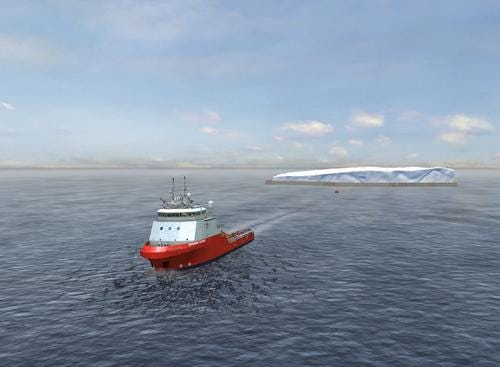Dassault Puts Inventor's 'Ice Dream' to 3D Simulation Test
August 25, 2011

There are far-out ideas, and then there are those ideas that are just totally out there.
Georges Mougin, an 86-year-old eco-entrepreneur, has been pursuing what most would say is one of the more crazy ideas for more than 40 years. Supported by renowned ice experts and the onetime backing of a Saudi prince, Mougin has been tirelessly researching and pitching his concept for harvesting and transporting icebergs to solve the world's water shortages. Given the complex technical obstacles and the astronomical budgets associated with trying to get a real-life prototype of his system off the ground, the idea progressed in fits and starts over the years -- that is, until the 3D tool leader Dassault Systemes got involved.
Dassault picked Mougin's "Ice Dream" concept as one of the handful of "Passion for Innovation" projects the company takes on annually. With this initiative, the company lends its arsenal of 3D modeling and simulation tools and an army of top-shelf engineering experts to explore far-out concepts. In turn, the company can promote the results to showcase the power of 3D virtual design. One of Dassault's more prominent efforts was a project several years back with the French architect Jean-Pierre Houdin to solve the mystery of how the Pyramid of Kheops was built.
Mougin's idea boils down to this: Capture a tabular iceberg (its flat top means less chance of fracturing during transportation); protect it from melting using an innovative belt and skirt made from non-woven geotextile strips; and transport it across the globe via a single, high-powered tugboat and kite board combination. The goal is to use as little energy as possible by following the natural movement of the ocean currents.

"Because it sounded crazy, we wondered if Mougin was right or wrong," Cedric Simard, Dassault's project director for worldwide experiential marketing and interactive communications, told me, explaining there were strong arguments both in favor of and against the concept. "If 3D could help get an objective view on the project, we thought it was worthwhile to figure out."
The pilot project for the 3D virtual test was mapped out with the island of Newfoundland chosen as the departure point due to its proximity to icebergs and ocean currents that favor towing. The Canary Islands were picked as the final destination since they have water shortages and already employ desalination techniques. The simulation called for the transport of a 7-million-ton tabular iceberg using a tugboat with a tractive force of 130 tons, and a fixed route between the two destinations.
Working together, the Dassault/Mougin team's first step was to create a precise model of the tabular iceberg in CATIA based on real data collected on icebergs in the Newfoundland area. The next step was to design a two-part simulation to determine how the iceberg would melt along its journey. The team created a hydraulic simulation to mimic the interactions between the iceberg, protected by Mougin's innovative skirt design, and the natural environment, varying parameters like the speed and temperature of the sea currents to reproduce the actual conditions the iceberg would encounter.
About the Author(s)
You May Also Like



